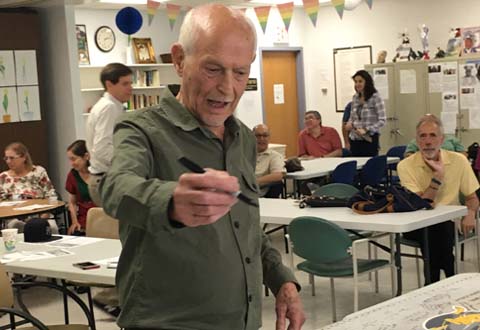"I Will Survive!"

Ed Field, an Air Force First Lieutenant, who flew 27 missions on a B-17 as a young navigator, with the 384th Bomb Group in 1945, signs the wing of the plane he was shot down in during World War II.
Air Force First Lieutenant, Edward Field flew 27 missions on a B-17, as a young navigator with the 384th Bomb Group in 1945.
Based in England, on his third mission over Berlin, “dumping bombs on an already smoking city,” his plane was shot up. Down to two engines, the bomber headed back to England via Holland. And then, out of gas, crash-landed in the North Sea. The crew evacuated to two rubber rafts that broke away, one only half-inflated with the pilot, the other with the rest of the crew, leaving Field standing on the wing of the still-floating plane. But Field, a strong swimmer, made it to the sturdier raft and clung to its side in the icy water.
“I said over and over to myself I will survive,” recalls Field, and kept asking to be let on the over-crowded raft. Jack Coleman Cook, an enlisted man from Arkansas, known to his fellow airmen as “the little gunner,” jumped into the sea to make a place for Lt. Field. Finally, they were rescued by an English ship, but Cook died of exposure. And, although the 93-year-old Veteran says that after the war, he put his service experience behind him, the knowledge that a man died for him to live, he says, is something he can never forget. “I chose to live rather than be a hero.”
After a long period of recovery, Field went to Paris after the war, to become a poet. Later, he moved back to NYC where he has lived for many years at the Westbeth artists housing. “I’ve had a wonderful life,” he says. “The only thing I haven’t done is learn to skateboard. Something my partner Neil Derrick won’t let me do.”
An engaging man, with many friends, and after a long career giving poetry readings around the country, Field was comfortable in the limelight at a recent wing signing event held at VA’s Manhattan Campus. Tracked down by a group committed to locating the survivors of Bomber 384 and having them sign a part of a wing panel of one of these war planes, they now have 145 signatures. Field was both surprised and pleased to place his John Hancock on the panel. Eventually, the piece will be housed in a small museum at Hill Aerospace Museum at Hill Air Force Base in Utah.
Field has written four books of poetry, his memoirs and the narration for an Academy Award winning documentary. During the program at the hospital, Field read two of his poems about his WWII experience, interspersing the reading with moving comments about the war.
















